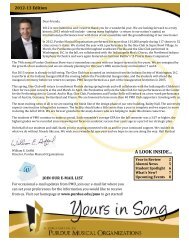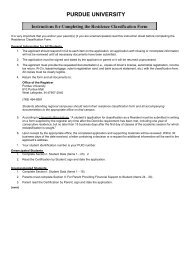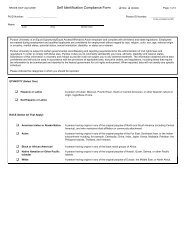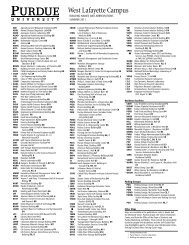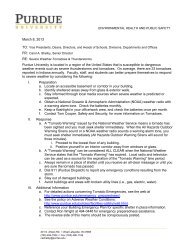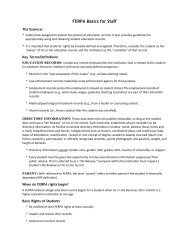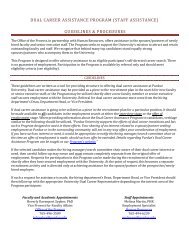Student Health Center - Purdue University
Student Health Center - Purdue University
Student Health Center - Purdue University
You also want an ePaper? Increase the reach of your titles
YUMPU automatically turns print PDFs into web optimized ePapers that Google loves.
Start Date September 20, 2006<br />
Finish Date<br />
1 of 6<br />
<strong>Student</strong> <strong>Health</strong> <strong>Center</strong><br />
Electronic <strong>Health</strong> Record<br />
Project Charter<br />
Introduction<br />
An Electronic <strong>Health</strong> Record (EHR) is a medical record or any other information relating to the past, present, or future<br />
physical and mental health, or condition of a patient which in an electronic data format that is captured, transmitted, received,<br />
stored, retrieved, or linked for the primary purpose of providing health care and health-related services.<br />
The PUSH EHR Project encompasses much more, though, that the EHR module in PyraMED. This project will include<br />
several phases. These phases introduce different pieces of the EHR module to the daily processes of the <strong>Student</strong> <strong>Health</strong><br />
<strong>Center</strong> and ancillary sub-systems (i.e. – CR/PACS and RxWriter). As a whole, these phases will complete a fully operational<br />
EHR system.<br />
The <strong>Purdue</strong> <strong>University</strong> <strong>Student</strong> <strong>Health</strong> <strong>Center</strong> has been given a unique opportunity: the vendor of its current health<br />
information system, PyraMED, is offering their version of the EHR free of charge. PUSH is also in a position to take<br />
advantage of this offering in terms of provider interest, available resources, and parallel projects (Laboratory Information<br />
System) that will benefit both endeavors.<br />
Objectives<br />
The objective of this project will be to:<br />
1. Have installed a working version of the EHR in both the PyraMED Production and Test environments.<br />
2. Complete each phase of the project outlined in attachment A where possible (limitations exist where Media Highway may<br />
or may not have certain modules available for implementation).<br />
3. Interface with existing LIS.<br />
4. Install and interface with a CR/PACS.<br />
5. Create a sub-department of the Medical Records department that coordinates the scanning and indexing of paper<br />
documents into electronic health records stored in PyraMED.<br />
6. Interface with <strong>Purdue</strong> <strong>University</strong>'s Pharmacy system.<br />
7. The building and implementation of Forms in the PyraMED EHR for use by the Providers.<br />
8. Training of Pilot Group and "Go Live" of Pilot Group for each phase.<br />
9. Feedback sessions with Pilot Group for each phase.<br />
10. Training of Clinic and "Go Live" of Clinic for each phase.<br />
Scope<br />
1. The <strong>Student</strong> <strong>Health</strong> <strong>Center</strong> will be responsible to manage the information between campus departments that are needed<br />
to accomplish this project. PUSH will supply the other campus departments a schedule and timeline. PUSH will verify 1)<br />
that all objectives are met in the project, and 2) that all software installed functions as needed.<br />
2. <strong>Student</strong> Service Technology Assessment will provide advice and direction to the <strong>Student</strong> <strong>Health</strong> <strong>Center</strong> during the project<br />
and help prioritize departmental task lists to include deliverables within the project to meet scheduled deadlines.<br />
3. <strong>Student</strong> Services Workstation and Technology will provide resources and manpower to implement workstation-side<br />
software and hardware components that are required by the EHR module to function properly. SSWT and PUSH will<br />
work together to test and verify software and hardware builds and installs.<br />
4. The Infrastructure of Information Technology at <strong>Purdue</strong> will consult with PUSH on a minimal number of phases during<br />
the project. In phases associated with PyraMED, ITaP will work with PUSH to help determine storage growth of the<br />
PyraMED database due to the EHR and Document Imaging. ITaP resources will also be requested during Phase Three,<br />
Computerized Radiology as ITaP will be asked to house the Picture Archive Communication System (PACS) for power<br />
backup options and possibly data backup solutions. Most other phases of the project will not require ITaP resources as<br />
the several phases of the project incorporate features that already exist in PyraMED.<br />
5. Information Technology Security and Privacy and Internal Audit will verify the security and privacy of the EHR module<br />
and other sub-systems included in the project.
2 of 6<br />
EHR Project Charter<br />
6. Media Highway, vendor and supplier of the EHR module, will fill the roles as provider of software and documentation,<br />
support center, installer (server-side) and trainer.<br />
7. Radiation Services of Indiana, vendor and supplier of the CR/PACS component of the system, will fill the roles as<br />
provider of software and documentation, support center, installer (server-side) and trainer and it relates to CR/PACS.<br />
Deliverables<br />
1. Staff Requirements<br />
a. Identify Executive Sponsor<br />
b. Identify Steering Committee<br />
c. Identify Core Team<br />
2. Timeline<br />
3. Phases outlined in attachment A.<br />
4. Milestone<br />
5. Implementation<br />
6. Developed agreed upon schedule<br />
7. Long-term structure<br />
Staffing<br />
1. Executive Steering Committee - Its primary purpose is to provide high-level focus, oversight, and strategic guidance<br />
and vision to the Program. Providing high-level direction on business impacts and technical approach and ensuring proper<br />
and complete resources are engaged. Ensuring all <strong>University</strong> policies are engaged to properly manage risk.<br />
a. Lee Gordon...................................................Assistant Vice President, <strong>Student</strong> Services Technology and Assessment<br />
b. Steve Baker....................................................<strong>Student</strong> Services Technology Director<br />
c. James Westman ............................................Director, <strong>Student</strong> <strong>Health</strong> <strong>Center</strong><br />
d. Susan Prieto-Welch......................................Director, Counseling and Psychological Services<br />
e. Mike Rubesch ...............................................ITaP<br />
f. Peggy Fish .....................................................Internal Audit<br />
2. Steering Committee - Its primary purpose is to make major decisions in the best interests of the EHR project and to<br />
ensure that the project adheres to its fundamental principles found in the project's objectives, scope, and deliverables.<br />
Ensuring all <strong>Purdue</strong> <strong>University</strong> policies are being properly followed to manage risk. This group will help to spread the<br />
strategic input and buy-in through-out PUSH and the rest of the university community, and this group will meet<br />
periodically to evaluate the progress and success of the implementation of the EHR technology solution.<br />
a. Susan Clark....................................................Co-Project Manager (Processes)<br />
b. Janet Moore ..................................................IT Consultant, SSTA<br />
c. Greg Sabens..................................................Co-Project Manager (Technical)<br />
d. Sarah Sayger ..................................................Medical Clinic, PUSH<br />
e. Bob Wallace ..................................................Manager of Business Office, PUSH<br />
f. Joan Vaughan ...............................................Director, HIPAA<br />
g. Jim Slopsema ................................................ITaP<br />
h. Diana McKinney..........................................ITaP ITI<br />
i. Greg Hedrick................................................ITaP Security and Privacy<br />
3. Project Team<br />
a. Patti Emshousen ..........................................Computer Services, PUSH<br />
b. Tamara Hazbun............................................Medical Clinic, PUSH<br />
c. Luke Pickett ..................................................Computer Services, PUSH<br />
d. Joyce Roosz...................................................Business Office, PUSH<br />
e. Sarah Sayger ..................................................Medical Clinic, PUSH<br />
f. Ernest Stalnaker ...........................................DBA, ITAP Infrastructure<br />
g. Peggy Fish designee.....................................Internal Audit<br />
h. PUSH Key Players
3 of 6<br />
EHR Project Charter<br />
Assumptions<br />
1. Information Technology at <strong>Purdue</strong> will continue to support the PyraMED database on the Oracle servers. A new SLA to<br />
be drawn up for phase 3, Computerized Radiology and the Picture Archiving Communications System (CR/PACS).<br />
2. Media Highway, the vendor, will continue to support and help maintain PyraMED, along with the new EHR, within their<br />
abilities to access the system. Their level of access will remain constant.<br />
3. <strong>Student</strong> Services Workstation Technology will continue to provide workstation support to the point that the PyraMED<br />
client installed on <strong>Student</strong> <strong>Health</strong> <strong>Center</strong> workstations will run without issue that result in negligible loss of system<br />
effectiveness and functionality.<br />
4. The Computer Services department of the <strong>Student</strong> <strong>Health</strong> <strong>Center</strong> will continue to support the PyraMED <strong>Health</strong><br />
Information System as system administrators and work as liaisons between the aforementioned departments to help<br />
during software upgrades, running maintenance, determining resolutions to issues, and other activities that ensure the<br />
continue availability of the system.<br />
Schedule<br />
For project timelines and dates, see Attachment A. Listed below are descriptions for each phase, resources required and<br />
required steps to be completed for each phase of the project.<br />
Phase 1 – Planning<br />
Description: The creation of the timeline, engagement of key players, and installation of the EHR module.<br />
Resources: Medical Staff, Media Highway Training, Application of the EHR module to the PyraMED Core System, PUSH<br />
Computer Services<br />
Phase 2 – EHR –Move to EHR Coding<br />
Description: In this phase, we move the providers from coding in the old, PyraMED Coding screen to the new EHR<br />
Coding screens. Other than a change in the environment, the process is the same for providers. This will give them<br />
the chance to become familiar with the new EHR screens but require nothing new from them.<br />
Resources: Medical Staff, PUSH Computer Services<br />
Phase 3 – Computerized Radiology<br />
Description: Installation and configuration of the PACS and CR systems as well as the interface with the existing<br />
PyraMED Core systems.<br />
Resources: Radiation Services, ITaP server and support group, SSTA, SSWT, Radiology Staff, Dr. Miller (et. al.), PUSH<br />
Computer Services, Media Highway Interfacing<br />
Phase 4 – Notifications<br />
Description: This is an intra-system messaging module at patient level that allows sign off and other communications<br />
between staff. This already exists in the core PyraMED system but is currently inactivated.<br />
Resources: Medical Staff, Nursing, Lab and Radiology, PUSH Computer Services<br />
Phase 5 – Referrals<br />
Description: This PyraMED Core module will allow providers and staff to create referrals to community physicians and<br />
specialties. We are also going to be using this to refer patients internally to other PUSH departments.<br />
Resources: Physical Therapy, Medical Staff, Nursing, PUSH business office, CAPS, PUSH Computer Services<br />
Phase 6 – Document Indexing<br />
Description: This module allows multimedia images to be associated with patient records. This includes the scanning of<br />
external documents and historical paper records as well as the importation of anatomical graphics and digital photos.<br />
Resources: Medical Records Group, SSTA, SSWT, PUSH Computer Services, Media Highway Support Team, ITaP<br />
servers group<br />
Phase 7 – EHR- RxWriter and Pharmacy interface<br />
Description: The RxWriter module provides the ability to automatically check ordered prescriptions for interactions and<br />
allergies. This module also allows printing and electronic sending of prescriptions. The Pharmacy interface would be<br />
the other part needed for the sending of electronic prescriptions to the existing QS1 pharmacy system at the School of<br />
Pharmacy. This bridge from PyraMED to QS1 will also allow additional information for the providers regarding the<br />
prescriptions.<br />
Resources: Pharmacy, SSTA, SSWT, PUSH Computer Services, Media Highway Interface Team, QS1 Interface Team,<br />
Medical Staff
EHR Project Charter<br />
Phase 8 – Transcription<br />
Description: There are currently 2 possibilities being developed by Media Highway. The first would allow direct recording<br />
into the chart and transcription of this recording either by means of software such as Dragon Speak or by a<br />
transcriptionist. The second and less preferable method would allow import of external transcription using a ridged<br />
format structure. This second method requires we maintain the external transcription system.<br />
Resources: Medical Records Group, PUSH Computer Services, Medical Staff, Nursing, Media Highway, SSWT<br />
Phase 9 – EHR – Forms and Electronic SOAP Notes<br />
Description: This phase truly moves PUSH into the electronic health record era. Having completed the previous phases,<br />
we will be in a position to use the EHR module to its fullest capacity. In this phase, we will begin the use of<br />
electronic forms in order for providers to document their encounters electronically by limiting the necessity of<br />
transcribed notes on the chart. The forms allow standardization of documentation on encounters.<br />
Resources: Medical Records Group, PUSH Computer Services, Medical Staff, Nursing<br />
Dependant Phases: 10, 11, 13<br />
Phase 10 – Recalls<br />
Description: The recall module extends patient care by providing the Providers with a way to create reminder notifications<br />
for follow-up care.<br />
Resources: Medical Records Group, PUSH Computer Services, Medical Staff, Nursing<br />
Phase 11 – Electronic Signature<br />
Description: Media Highway is developing an interface so that electronic signature pads can be connected to the<br />
PyraMED system. This will allow patients and staff to electronically attach their signature to encounters.<br />
Resources: Medical Records Group, PUSH Computer Services, Medical Staff, Nursing, Media Highway, SSWT<br />
Phase 12 – EKG<br />
Description: Media Highway is developing an interface to allow for real-time communication between an EKG machine<br />
and PyraMED. We will be dependent upon Media Highway’s development of this module and the EKG machines<br />
interface structure.<br />
Resources: Medical Records Group, PUSH Computer Services, Medical Staff, Nursing, Media Highway, SSWT<br />
Phase 13 – Complete – Review and sign-off of the completed project.<br />
Costs by Phase<br />
2. EHR Coding - non-recurring; $0, recurring; none, training; $7000<br />
a. EHR Module is provided to us at no cost ($30,000). No additional hardware requirements.<br />
b. Training for staff occurred April at Media Highway.<br />
3. CR/PACS - non-recurring; $175000, recurring; $~$1,000<br />
a. The purchase price of the 2CR/PACS is $170,000. We have secured a $40,000 discount from the vendor.<br />
b. We are currently defining the contract with the vendor for the annual licensure fee that includes support.<br />
c. Costs from ITaP to house the server are currently unknown. SLA to define this to be finalized by end of year.<br />
d. Media Highway costs to setup interface to costs $5,000. Approximately $1,000 added to annual licensure fee.<br />
e. ITaP backup costs are approximately $3/GB of backed up data.<br />
4. Notification - non-recurring; $0, recurring; $0<br />
5. Referrals - non-recurring; $0, recurring; $0<br />
6. Document Indexing - non-recurring; $3270 + Scanners, recurring; ~$1,000, cost for increased data storage needs.<br />
a. We were given a 20% discount on the purchase price of the Document Indexing software.<br />
b. There will be a cost involved to purchase acceptable scanners.<br />
c. Increase in the annual licensure fee to Media Highway will be approximately $1,000.<br />
d. Costs for increased data storage due to EHR Form (phase 9) will be calculated during this time. Projected<br />
growth of data storage due to EHR is 10% above normal growth experienced to this point.<br />
7. RxWriter - non-recurring; $7940 + $7500 + printer purchases, recurring; $4140 annual cost for FirstDataBank<br />
a. We have received a 47% discount on the purchase of the RxWriter software.<br />
b. An interface will be required between <strong>Purdue</strong> Pharmacy’s QS-1 system and PyraMED. Typical PyraMED<br />
interfaces cost $7500.<br />
c. We are considering additional printers for prescription printing. Costs for this to be approximately $2000.<br />
d. There will be an annual cost for use of the FirstDataBank information. This allows the RxWriter to remain<br />
current to drug and allergy interactions.<br />
4 of 6
5 of 6<br />
EHR Project Charter<br />
8. Transcribing - non-recurring; unknown, recurring; unknown<br />
a. Media Highway is working on a transcription system. They have not release details.<br />
9. EHR Forms - non-recurring; $0, recurring; $0.<br />
10. Recalls - non-recurring; $0, recurring; $0<br />
11. E-Signature – non-recurring; unknown, recurring; unknown<br />
a. Media Highway is considering creating software to work with electronic signature pads. Signature pads retail<br />
for ~$300 and more. We do not know if there will be a cost involved with the software from Media Highway.<br />
12. EKG Interface - non-recurring; ~$7500 but unknown, recurring; unknown<br />
a. Media Highway is working on an interface to EKG machines. It is unknown if there will be charges for the<br />
software.<br />
b. If an interface is required, the current cost for PyraMED interfaces is $7500.<br />
c. We do not yet know if we would be required to purchase a different EKG machine in order to interface with<br />
PyraMED.<br />
Summary of costs<br />
Phase Non-recurring Recurring Savings Unknowns<br />
2 $7,000 $30,000<br />
3 $175,000 $1,000 $40,000 ITaP Support Charges<br />
6 $3,270 $1,000 $654 Scanner Hardware, ITaP Charges for Storage<br />
7 $17,000 $4,140 $3,730<br />
8 Media Highway Transcription System cost<br />
11 E-sig Pads, Media Highway Software<br />
12 $7,500 Media Highway Software, new EKG machine<br />
Totals $204,770 $6,140 $74,384<br />
Risks<br />
Currently, the <strong>Student</strong> <strong>Health</strong> <strong>Center</strong> uses a pneumatic tube system to convey paper medical charts throughout the building.<br />
This 40 year old system is in constant repair and all those repairs are done in-house as there is no longer any support from the<br />
original vendor.<br />
Benefits<br />
1. Immediate and universal access to the patient record through predetermined levels of security, thus ensuring HIPAA<br />
compliance.<br />
2. Easier and quicker navigation through the patient record.<br />
3. The elimination of misdirected physical paper charts.<br />
4. The standardization of visit documentation among providers within the organization.<br />
5. Clinical data formatted so to easily read and analyze.<br />
6. The reduction of paperwork, documentation errors, and filing activities and the associated costs.<br />
7. Greater efficiency in completed visit documentation.<br />
8. The invaluable ability to create alerts for medication errors, drug interactions, and patient allergies.<br />
9. The possibility to electronically transmit information to other providers (history, treatments, prescriptions, etc.).<br />
10. The availability of clinical data for use in quality, risk, utilization, auditing, and return on investment analyses.<br />
11. Eliminating the need for the antiquated physical tubing system and various costs associated with the upkeep of it.<br />
Estimated yearly costs of parts is $3500, and labor and maintenance $8000.<br />
12. The elimination of chart folders, stickers, labels, forms, outguides, and other paper products will approximately reduce<br />
Medical Records costs by a surprising $17,000 per year. Another $3,000 per year will be saved in printing costs.<br />
13. Spending on <strong>Student</strong> worker positions can be reduced over time saving ~$60,000 per year to the <strong>Student</strong> <strong>Health</strong> <strong>Center</strong>.<br />
14. We will realize an average, annual savings of approximately $16,000 in the Radiology department with the elimination of<br />
paper used for orders and reports, fixer and developer, processor service contract, film, jackets and labels, reprints,<br />
departmental losses due to uncharged copies, etc. In addition to this, over all, the student population will see a savings of<br />
over $3000 saved for copies that are charged by the department.<br />
15. A decrease in spending in subsequent years by no longer purging and destroying paper documents (after 7 year retention<br />
period phase out), more than $500 per year currently (Ten cents per pound. 4,336 pounds disposed of on last trip).
Signatures<br />
_________________________________________________________ ______________<br />
Lee Gordon Date<br />
_________________________________________________________ ______________<br />
Steve Baker Date<br />
_________________________________________________________ ______________<br />
James Westman Date<br />
_________________________________________________________ ______________<br />
Susan Prieto-Welch Date<br />
_________________________________________________________ ______________<br />
Mike Rubesch Date<br />
_________________________________________________________ ______________<br />
Peggy Fish Date<br />
6 of 6<br />
EHR Project Charter






